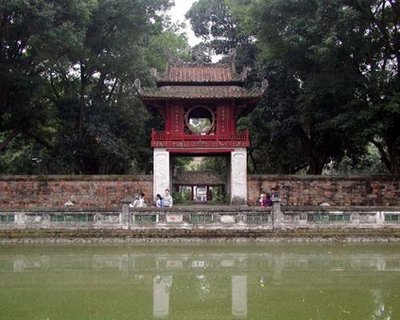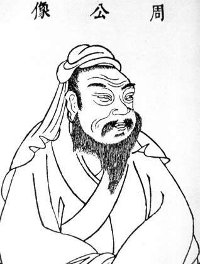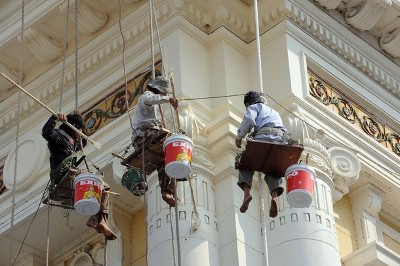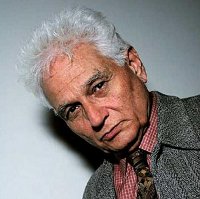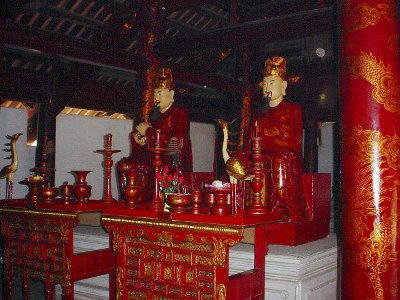“The Chinese Domination” (5) and “Taking on Tradition” (9), from A Visit to Vietnam
9: Taking on Tradition
The Van Mieu, established in 1070 A.D., is a monument to Confucius. Second random street elevation, non-touristic neighborhood, Hanoi. While scholarly culture flourished in the cities, popular culture, with its nationalist calling, often despised by a westernized elite, took refuge and was perpetuated in the countryside. Similar to the mieu, or Confucian temple, found both then and now in villages throughout Viet Nam. A motorcycle (“Dylan 150”) pulls up to a professional cell phone op seated on a black plastic sidewalk stool, while adjacent seller of coffee beans prepares for author a cup of java. In 1075 the Royal College opened on the same site to prepare princes for the governance of the country. Spirituality was guarded by ancient popular beliefs and the unified triple cult of Confucianism, Buddhism and Taoism. Having finished his call, the guy on the Dylan departs, his girlfriend seated behind him, her arms circling his waist. This explains why Christianity had difficulty implanting itself in Viet Nam. A year later the college was renamed School for the Sons of the Nation.
Across-street view into pharmacy/clinic, its sign above a white circle on a blue ground, within which an orthodox red cross, beneath which, in green, the word “Yersin.” Gaining a foothold in the 17th century, Catholicism, unlike Buddhism, Confucianism and Taoism (other imported religions) was unable to clothe itself in the national character. To the clinic’s right, a paint store, its sign, not surprisingly, all in Vietnamese. For 700 years, until the Nguyen dynasty moved the capital and the university to Hué, the school fostered some of Viet Nam’s greatest statesmen and men of letters. To the left, “Yen Nhi / Collection,” a fashion outlet, its window filled with silver Christmas ornaments, a green wreath hung half over the window, half above the open door. The principle reason for this was intransigence. In its present form the Van Mieu is modeled after the Temple of Confucius at Qufu in China, with the five courtyards representing the five essential elements of nature. Christianity allows no other divinities than its own and bans the cult of ancestors.
To the left of the fashion boutique is a store selling cookies, crackers, cigarettes, soft drinks, candy, wine and bottled water. A visitor’s walk through the temple grounds provides an introduction to the history of the country, to Confucianism and to the special place that education and literature have long held in Vietnamese culture. To the right of the paint store, another paint store. In addition, Vietnamese Catholicism is marked by its “original sin”: The complex began as a temple to both Confucius and the Duke of Zhou, a member in the 11th century of the Chinese royal family. It appears anti-nationalist, because from the time of the French conquest the cross has served the sword. (The Duke of Zhou is credited with originating the teachings that Confucius developed 500 years later.) The second stories are all different: During the colonial period and the two national wars the church sided with the foreigners. A bricked wall into which sliding glass doors have been fitted; a dilapidated house front, boarded up; an elegant balcony; a facade of French windows and shutters.
Vietnamese-ness in brief: Pedestrians must use the street, for in this neighborhood the sidewalks are all blocked. Five courtyards separated by brick walls comprise the interior. (1) The predominance of the Vietnamese ethnic majority, which inhabits the lowlands. A convoy of rickshaw-driven Korean tourists passes, four vehicles followed by another four, an older Korean man fanning himself with a Hangeul newspaper. In Confucian as well as Buddhist numerology the number five has a special place. (2) The Southeast Asian substratum in Vietnamese culture, onto which foreign cultural elements, Asian as well as western, have been grafted. A guy scoots by with two girls on the back of his motorbike, followed by another girl in a pink sweater on her own motorbike, an expensive handbag nestled between her feet. There are five essential elements, five basic virtues, five commandments, five sorrows, five cardinal relationships and five classics. (3) The principle of repulsion-attraction governing the Vietnamese assimilation of foreign cultures.
Walking up the street in the opposite direction a woman in her thirties, dressed in conical hat and black super sleeves, pushes on by in rhythmic motion, as she bears on her shoulder pole the burden of two baskets, one filled with oranges, one with apples. A central pathway divides the complex into symmetrical halves as it leads the visitor through the different courtyards to the temple altar. In the period from 179 B.C. to the mid 19th century Chinese acculturation demonstrates this principle. (In the shoulder pole with its inseparable baskets, the doi quang, has been seen the image of conjugal fidelity.) Each courtyard is connected to the next by three parallel gates that bear names symbolic of advancing wisdom. In the period from the mid 19th century to 1945 French acculturation again demonstrates the principle. Three motorcycles arrive, each with a large cargo of several boxes. Parallel Chinese couplets are inscribed on the side columns of these gates. Resistance to the Americans and the subsequent absorption of American culture also demonstrate the principle.
A white man, wearing a tie, a black daypack strapped to his back, walks by on his way to lunch. A walk through the courtyards of the Van Mieu recalls the Confucian scholar’s progress in following the path to knowledge. The great national upheavals of revolution, war and their aftermath. Author passes through the gateway, pleasantly illuminated by the mid-day sun. Including the drama of integration into the world community. We have left behind in the outer courtyard five recently planted palm trees, on either side of the path. Has turned the cultural setting of Viet Nam upside down. As author enters the second courtyard, a woman wearing a tiger striped top exits through the portal. In a world full of movement and transformation. We traverse the first courtyard (“The Entrance to the Way”), bordered on each side by five clumps of poinsettias. Viet Nam. The sound of vehicular traffic has diminished. Subjected to a wide range of influences. A girl with a dragon on her tee shirt takes out her cell phone. Is searching to redefine, without repudiating, its identity.
The journey begins with respect. Inside the second portal a plaque explains the program of instruction at the National College. Each of the two tallest pillars is topped with a mythic beast, the Ly, which has the power to distinguish right from wrong, good from evil. They paid special attention to “the Four Books,” it says (the Da Xue, the Zhong Yong, the Lun Yu, the Meng-zi). For Derrida the phenomenon is the question, for there is no phenomenon without at least the possibility of the question, the possibility of posing questions about the phenomenon, including the phenomenon of the question, in a philosophical language with all the terms of opposition and logical constraint. But they were also examined on the five pre-Confucian classics (the Odes, the Annals, the Rites, the Book of Spring and Autumn, the Book of Changes), as well as ancient poetry and Chinese history. I thus propose to follow here what to my eyes is Derrida’s unfailing fidelity to the question, a fidelity that can never be reduced to the question and yet cannot be expressed without it.
We have passed into the Great Courtyard, where a child’s plastic ball, striped red and whitederrida, has been left behind on the scruffy St. Augustine’s grass. I will follow this fidelity to the question by asking about the way Derrida himself follows the question in another, that is, by following Derrida questioning Levinas on the role of the question and its relation to the phenomenon. Author peers into one of the two symmetrically designed lotus ponds, over which a large central banyan is branching out. We shall see that from beginning to end it is the question of the phenomenon and the phenomenon of the question that ceaselessly returns. A mother, ethnically Vietnamese, explains in English to her ten-year-old daughter, whose long dress in black and red is cut from the same piece of cloth as the mother’s, what the guide has just conveyed to the mother at great length in Vietnamese. “Among the doctrines of the world, ours is the best and is revered by all culture-starved lands,” says an inscription, “Of all temples devoted to literature, this is the head.”
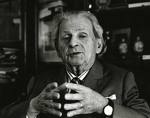
A Vietnamese guide, in black sandals, black pants, black shirt and black jacket is lecturing to three French tourists on the temple’s architectural design (we have reached the “Puits de la Clarté Céleste,” he tells them). Oriented or driven each time by a new concern within the work of Levinas, the question of the question always returns, the question of the relationship of philosophy as the realm or regimen of the question to that which exceeds philosophy, the relationship of ontology, if not phenomenology, to ethics. Virtue and talent are the keys to passage from the first to the second courtyard. Inside the third portal two Vietnamese college students are mechanically copying its bas-relief designs. Each time it is a question of the same and of something that resists both the question of the same, the possibility of philosophical language to receive or welcome what precedes or exceeds it. Author turns toward a portico filled with turtles bearing large plaques on their backs, heedful of a sign that reads, “Do not write, draw, step or sit on the Doctor’s Stelae.”
Cautiously he takes a seat, cheered by a smile from an eighteen-year-old Vietnamese girl in bright yellow sandals, who is seated with two of her fellow students, as a fourth girl with red daypack joins them for lively conversation. Two carp atop the simple gate symbolize students on their way to becoming mandarins. Meanwhile a rough French woman of 65 in grey and white basketball shoes takes a seat with her 70-year-old husband to flip the pages of their guide. From the publication of “Violence and Metaphysics” to his final Adieu it is a question of the necessary violence of ontogeny, a question of the inevitable and perhaps salutary interruption of the ethical relation, a question of the hospitality that can ever be offered to the Other once this relation is interrupted, a question of the welcome that can ever be reserved for it. A heavy-set Korean woman helps her pudgy daughter unfurl a bright green vinyl hammock only to watch as the daughter repacks it in its black plastic case, their Korean-speaking Vietnamese guide all the while keeping a respectful distance.
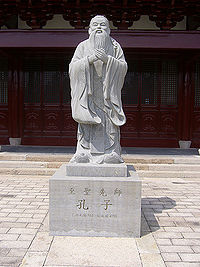
Entrance to “The Courtyard of the Sages” is through the Dai Than Mon, or Gate of the great Synthesis, which may also be translated the Gate of Great Success. At last the remainder of the Korean tour group catches up and draws the pair into their collective progress. The elements of the Confucian doctrine, the learning of the past and knowledge of Buddhism and Taoism are brought together here to complete a scholar’s erudition. Another of the eighteen-year-old Vietnamese girls turns about to reveal a sunflower hair catch holding her ponytail together, its five yellow plastic petals surrounding an orange center. Reading Derrida over the course of the last three decades, today, in the light of Adieu, we may begin to understand “Violence and Metaphysics” as a great text on hospitality, on a hospitality that is always granted by means of the question but can never be reduced to it. While the second eighteen-year-old student, she too seated, is turning to smile at author, a schoolmate appropriates one of her sandals to serve as her own improvised seat on the terrace.
Ahead lie the Gate of the Golden Sound and the Gate of the Jade Resonance. As we enter the Courtyard of the Sages, two middle-aged Vietnamese women dressed entirely in black make their appearance, one in an appliquéd blouse with transparent gauze sleeves. Yes, thirty years before Adieu, “Violence and Metaphysics” was, or will have been, a great text on hospitality, just as Adieu, as we shall see, can be read as a great text on the relationship between violence and metaphysical language, metaphysical understood here in both its Levinasian and its more traditional sense. Next appears a three-person group consisting of (1) an overweight 60-year-old Caucasian woman in short grey hair, (2) a Vietnamese woman of 30 in tight black pants and a sexy top, violet-and-black, (3) an eight-year-old blond girl in a lavender “I Wanna Dance” tee shirt, a yellow smiley face at its center. Historically the fifth courtyard served as a university, equipped with student classrooms, dormitories and cooking facilities, along with a print shop for school textbooks.
Today the courtyard is adorned with scraggly topiary sculptures resting uneasily in three urns at its entranceway, where a German-speaking Vietnamese guide in authentic accent has taken up his station to lecture on what he is calling the “Platz der Ceremonie.” “Violence and Metaphysics” can today be read as a series of reservations or questions posed to Levinas concerning the relationship between philosophical language, the language in which Levinas never ceased to write, and its ability to accept, receive or — and I’m now citing Derrida from 1964 — “welcome” that which is wholly “other” within it. Meanwhile an English-speaking guide identifies the frangipani leaves and branches overhead, as sunlight fills the courtyard and tourists of many nationalities approach the altar to Confucius to practice their amateur photographic art. How, Derrida was asking more than thirty years ago, can Levinas’s language be hospitable to that which is foreign to it without posing serious questions, that is, without posing serious questions to this “other” . . .
. . . without therefore requiring an answer that would translate the language of the foreigner or stranger — the question that is the stranger — into the language of the host, that would transform into a phenomenon that which exceeds and resists all light? In traditional ao dai — pink, yellow, magenta, salmon — a passel of four Vietnamese girls materializes from nowhere. Modern Vietnamese critics of this form of education. A tiny fly settles on author’s pant leg. Object to its focus on memorization, its lack of attention to practical learning, its neglect of Vietnamese history in favor of foreign (Chinese) history and culture. Two Japanese girls in jeans and black tee shirts — one reading “A Fire Within,” the other, “Striving Towards Altruistic Realm” — are joined by two more girls, in green and white tee shirts, who photograph them. They speak of its irrelevance, of “sitting on the bridge in Do and talking of the land of Moc.” Author, leaving behind this photographic frenzy, strolls toward the sanctuary of Confucius, who, on a plaque, is described as follows:
“Intelligent, calme, passionné d’études, il était célèbre pour son érudition avant l’âge de trente ans.” To circumscribe these questions of language and hospitality, Derrida spoke, already in 1964, of the relationship between inside and out. We have stepped out of the sunlight and into the temple. “Des élèves venaient de partout pour suivre son enseignement.” Celebrant-worshippers bow in reverence. “À partir de 54 ans, avec des disciples, il voyagea dans plusieurs principautés pour parfaire ses connaissances et propager son savoir.” “Will a non-Greek,” he asked, “ever succeed in doing what a Greek could not do, except by disguising himself as a Greek?” To reach the image of Confucius we must cross a very narrow courtyard; stepping over a lintel, we confront the porcelain image. “À 68 ans il retourna à Lo pour écrire et enseigner à prés de 3000 disciples.” Two red candles burn before the red-robed sage. “Il mourut à 73 ans.” Two bouquets of roses have been inserted into two bronze vases atop the modest altar, beside which rise two red columns.
